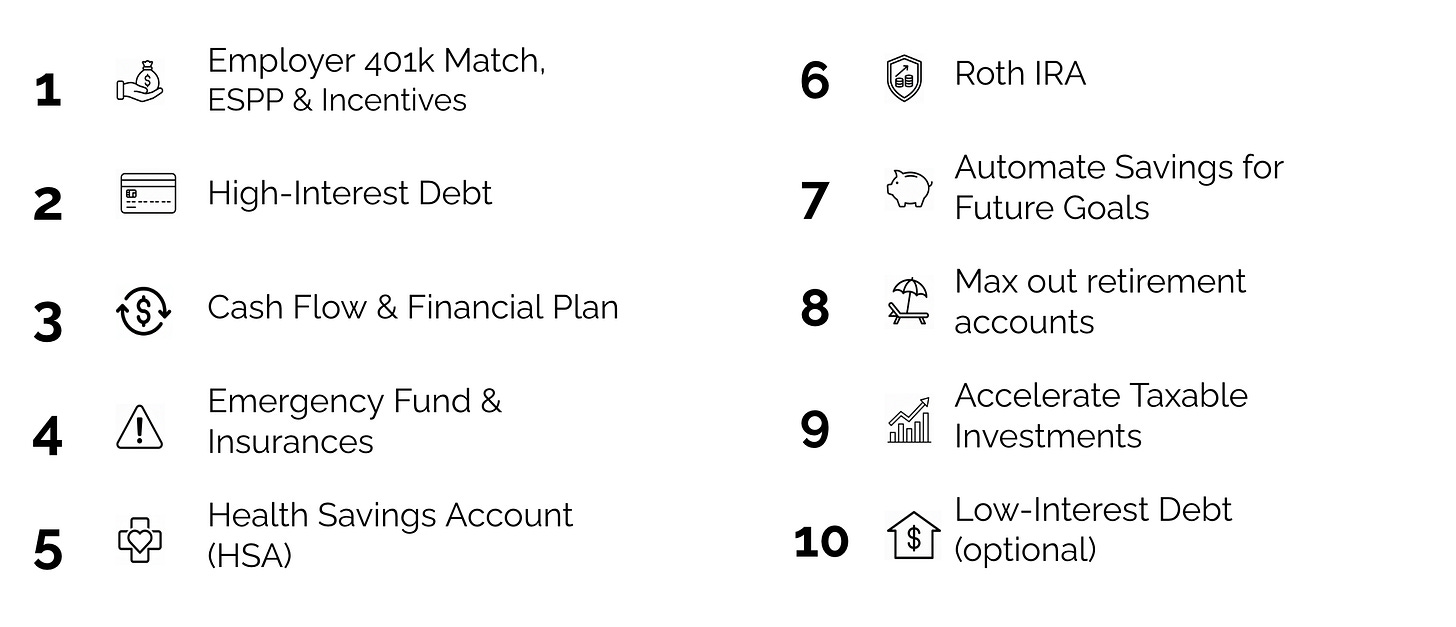What should I do next with my money? The 10 Steps to Wealth.
The only 10 steps you need to cover all of your financial bases.
Most people don’t struggle with money because they lack discipline. They struggle because they just aren’t quite sure what to do next.
Financial advice is everywhere: invest here, pay off that, buy this. Real wealth doesn’t come from chasing one random idea after another. It comes knowing what’s important to do first, second, third, and so on.
This guide cuts through the noise. It gives you the 10 most important steps to build lasting wealth, reduce financial stress, and create freedom - in the right order.
Whether you’re just getting started or refining your plan, these 10 steps keeps you focused on what matters most - one thing at time.
A few general principles to keep in mind
Align with your partner: Talk openly about financial goals and habits and make sure you are working toward a shared vision. It’s ok if you think differently about money. If one’s a spender, one’s a saver, use them as assets to balance each other and build a stronger team.
Give generously: Contribute to your community through time, money, or action. Focus on what you can give now; abundance builds happiness, networks, and long-term wealth.
Invest passively: Favor diversified, low-cost index funds for reliable long-term growth. Warren Buffet certainly thinks so. Real estate and other active investments can come later, once your foundation is set.
The 10 Steps to Wealth
1. Get your employer match for your 401k or 403b retirement account.
There’s no easier free money than your employer retirement account match. Not everyone gets a match, but if you do, take advantage of it before doing anything else, even before paying down credit card debt. Similarly, if your employer has a discounted stock purchase plan, take advantage of it in this step.
What if I don’t know what to invest in?
Enter the Target Date Fund. A target date fund is a type of investment fund that automatically buys all of the typical asset classes you need, sets the asset allocation based on your age, and then adjusts the asset allocation over time to optimize for a “target date,” commonly a person's expected retirement date. As the target retirement date approaches, these funds gradually shift from higher-risk investments, like stocks, to lower-risk investments, like bonds. They might have slightly different names depending on the funds that are offered, like Fidelity’s “Freedom Funds,” T. Rowe Price’s “Retirement Funds,” Schwab’s “Target Index Fund,” and BlackRock's “LifePath” funds.
Target Date Funds are fantastic. Asset selection and allocation are complex topics. Luckily for us, an army of economists at places like Vanguard are researching this for us and using it to design their Target Date Funds. And they come with low fees. Vanguard’s options are here. Simply look for the one with the year in the name that most closely matches your planned retirement year. Fidelity, BlackRock, and Schwab also have good options.
What if my 401k doesn’t offer Target Date Funds?
That is rare. Most large providers offer at least one option for an equivalent to a Target Date Fund. If that's the case, go with a 3-Fund portfolio of index funds with the lowest fee % that your 401k plan offers.
2. Pay down high-interest debt.
Process note: I recommend doing this step and the next step simultaneously. The two steps are mutually reinforcing, and it will make both steps more effective.
High-interest debt includes credit cards, payday loans, and personal loans. My general rule is any interest rate greater than >7% should be considered high-interest.
Paying down these debts is earning you more money because every dollar of principal you pay down means less interest charged to you next month. Do whatever you can to pay off more and more of the principal each month.
Which debt should I pay off first?
From a strictly financial point of view, paying off the debt with the highest interest should be paid off first because it generates the biggest benefit. However, some people find it more motivating to eliminate a single debt altogether. If that’s you, you can start by paying down the debt with the smallest balance so that you eliminate it and then move on to the next.
3. Start tracking where your money is going. Focus on the big picture only.
Detailed budgets don’t work for most people, and I don’t recommend them. Life is too variable to hold to the same $X for coffee and $Y for groceries every month. They often lead to extra stress and a feeling like you aren’t doing good enough. Thankfully, they also aren’t necessary to build wealth.
Even though budgets don’t work well, tracking your money without stressing about controlling every cent does work. It’s a subtle distinction but an important one.
There are great apps that do this for you with nearly no work. With Mint.com gone, I recommend Empower Personal Capital (free) or Monarch Money (paid). You link your credit card and bank accounts and then the tools import and categorize your spending and income for you.
Start by checking your spending every month or two. At this point, we want to understand the big picture of your spending and only focus on the things that matter. In particular:
Are your fixed costs <60% of your take home (housing, bills, groceries, car, gas)
Are you saving and investing something each month? The goal is to grow this over time to >15%.
Everything else is fun money. Do whatever you want with it!
Understanding is enough to help you start thinking differently and naturally make decisions that make sense without feeling like you are sacrificing. You may also notice areas where you are ‘leaking’ money that you can address and free up cash for other things (e.g. are you paying for a subscription you don’t use anymore?)
4a. Start building a right-sized Emergency Fund.
The standard advice is 3-6 months of essential living expenses. That’s a good starting point. However, depending on your situation and risk, how much you need is slightly different. To think about your risk, ask yourself - What could go wrong financially for me? How much would it be a problem if I lost my job? Or my spouse?
You should plan to have a larger emergency fund if you have a family, a big mortgage, and/or a single income. You could need less if you have two incomes and less fixed costs like housing and cars. If in doubt, aim for 6-months.
A High Yield Savings Account is the best option for holding your Emergency Fund. Pick an account that pays good interest from a reputable bank. Here’s a list of the highest-interest accounts right now.
4b. Add any missing insurances: Life insurance, long-term care, and disability insurance.
Aside from typical insurance that most people already have taken care of through their work (Health, Dental, Vision) or they are required to have (Home, Auto), there are few others that are valuable tools to manage financial risk.
Life Insurance
Life insurance is important if you have dependents, a mortgage, or any debts you don’t want to leave behind. You may already have access to it through an employer.
Term life insurance is often the simplest and most cost-effective option. It provides coverage for a set period (like 20 or 30 years) to protect your family when they need it most (e.g., while kids are young or you’re still paying off the house). If something happens, a policy can replace your income, giving your family financial security.
Disability Insurance
This one protects your income if you’re unable to work due to illness or injury. Many people don’t realize that becoming disabled, even temporarily, is sadly more common than we think. High earners rely heavily on their income, and disability insurance ensures you’re not financially stuck if you need to take an extended leave. Many employers offer short-term coverage, but having long-term disability insurance in place can give you even better peace of mind.
Consider Umbrella Insurance
Think of umbrella insurance as an extra layer of liability protection. An umbrella policy kicks in if you get sued and your regular liability coverage (say, from home or auto insurance) isn’t enough. That protection is especially helpful for people with higher assets or high-earning potential since it protects you against large liability claims or lawsuits that could otherwise be financially draining.
Consider Long-Term Care Insurance vs. self-insuring.
As we age, the likelihood of needing long-term care rises. Long-term care insurance is designed to help cover costs for nursing homes or in-home care, but it’s often not the best choice for those following this Playbook.
Why? It’s costly. Premiums vary by age, health, and coverage, generally starting over $1,500+/year in your 50s and jumping to $3,000+/year by your 60s. And the coverage is capped, while care can easily cost $50k+ per year for in-home services and $100k-$200k for facility care.
Instead, self-insuring is usually better for building wealth. Self-insuring means planning to cover these costs yourself by setting aside extra retirement savings. For most, it’s financially better than paying premiums. Adding this to your retirement planning helps cover potential health costs. Running the numbers on this aspect of your retirement goals can provide clarity (or consult someone to help).
Start early, and self-insuring becomes more achievable. However, if you’re getting a late start on saving, insurance may be the better option.
5. Contribute the maximum to an HSA and set up automatic investing.
HSAs offer a triple tax advantage that no other account can match, especially when you wait to use them to cover medical expenses in retirement when you often have the most costs to cover.
To open an HSA account, you must have a “high-deductible health plan” (HDHP), usually through your work. If you don’t have an HDHP, you must wait until your next open enrollment period to change your medical plans.
Why are HSAs so great? First, contributions to your HSA are tax-deductible, reducing your annual taxable income. Second, the money in your HSA grows tax-free. Third, when you withdraw the money for qualified medical expenses, it is also tax-free.
When you invest your HSA funds, it becomes a powerful investment vehicle. Most people use them as a fund to use to pay medical expenses as they happen. However, there’s a better strategy. If you can pay out of pocket for your medical expenses (earning cash back with your credit card!), rather than using your HSA, you can leave the funds in your HSA to grow tax-free. This creates another tax-free retirement account for you. Then, you can reimburse yourself for medical expenses at any time in the future, including in retirement, when you can expect significant medical costs.
How much is too much in an HSA?
There isn’t any ‘too much’ because there’s no downside to saving more in an HSA - even if you save more than what you need to pay for medical expenses in retirement. HSAs have another feature that allows you to withdraw money from them for regular retirement expenses, essentially turning them into a Traditional retirement account. Win-win.
This is the end of part 1 of the Playbook. In Part 2, we cover:
Maxing out your Roth or backdoor Roth IRA.
Automating savings for future goals
Maximizing your 401k or 403b.
Minimizing taxes.
Accelerating wealth growth in taxable investments.
Paying off low-interest debt.






Ready for part 2!
Super helpful! Eagerly waiting for part 2!